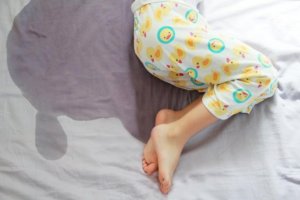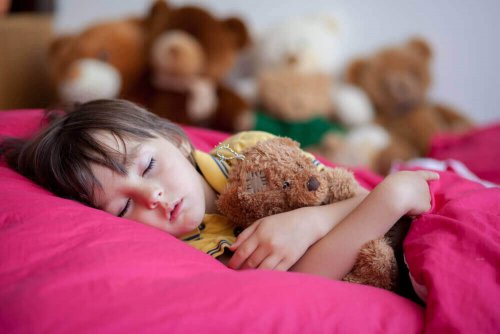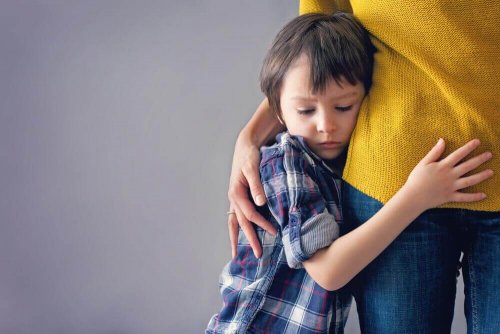How to Properly Treat Childhood Enuresis


Reviewed and approved by the doctor José Gerardo Rosciano Paganelli
Childhood enuresis is a form of urinary incontinence that usually affects children between the ages of five and six years. It is characterized by the repeated expulsion of urine, either during the day or in bed at night.
In order for it to be considered as a disease, the loss of urine must take place at least twice a week for at least a period of three consecutive months, as pointed out in this work carried out by researchers from the National Autonomous University of Mexico (UNAM). If it isn’t a disease, then it’s a behavioral problem.
The good news is that there are several ways to help your child learn how to establish proper and regular urinating habits. In today’s article, we’ll take a look at the main symptoms of this condition and several measures that can help you control them.
Symptoms of childhood enuresis

Children with this condition tend to have more difficulty waking up and may suffer from constipation. Furthermore, this is evidenced by research published in Pediatría Atención Primaria in 2009, as many authors point out a strong relationship between voiding disorders and constipation, since the stagnation of stool in the rectum impairs the functioning of the pelvic floor while urinating.
Criteria for diagnosis
In order to diagnosis childhood enuresis, the pediatrician or doctor in charge should consider the child’s age, urinary frequency, and medical background. They should also assess the parents’ attitude towards dealing with the problem and suggests some additional tests to rule out any other diseases.
Diagnosis is positive if:
- The child is between the age of four and six
- The involuntary leakage of urine occurs several times a week during a minimum period of three months
- Incontinence is most common during the night (wetting the bed)
- The loss of urine normally takes place between 30 minutes and 3 hours after going to bed
Read about The Six Best Self-Control Techniques
Treatments for childhood enuresis
Many parents don’t consult with a pediatrician when their children have childhood enuresis and in turn, they end up ignoring the treatment that’s required for this condition. Even though it’s true that the problem decreases as the child grows, sometimes it can get complicated due to not providing any proper treatment.
It’s important to provide a diagnosis on time because sometimes the condition has an underlying cause. Also, proper intervention prevents the condition from affecting a child’s social life. So, what’s the treatment?
Non-pharmacological treatments

A large part of the treatment for childhood enuresis focuses on correcting the child’s behaviors. Therefore, before the doctor suggests any medication, the physician must explain to you about the disease and give you some recommendations to counter it. It may include the following:
- Explain to the child and parents how the urinary system functions, and also explain some basic principles of enuresis
- Have the child and parents understand that no one is at fault for this condition because it’s beyond their control
- Insist to the family that they shouldn’t scold and embarrass the child. On the contrary, they should become supportive
- Ask the family members to have a positive attitude during the treatment. However, they shouldn’t be too active. This means the parents shouldn’t wake the child in the middle of the night in order to urinate.
- Explain to the child that they should consume plenty of fluids during the day and less after 7 pm
- Have the child write down their “dry” nights so they can see their progress
- Help establish regular urination habits to facilitate bladder control
- Promote good hygiene by telling them to change wet clothes
- Contraindicate the use of diapers, except in special situations
Pharmacological treatment
When the doctor recommends medication for childhood enuresis, the prescription may usually include desmopressin. This drug decreases the volume of fluid during the night. It has an effectiveness that can range between 40 and 80 %, as pointed out in this study published in the Revista Española de Pediatría: Clínica e Investigación.
Sometimes also the use of oxybutynin can be suggested, which acts by increasing the capacity of the bladder. Ultimately, the doctor may recommend imipramine, which has an antidiuretic effect. This option is only for specific cases due to side effects.
So, do you Want to Sleep Better? Try Out These Seven Nighttime Habits
Recommendations for parents

Childhood enuresis is a benign disorder that disappears as the child grows. However, given to the fact that for some parents this condition is difficult to manage, it’s worth going over some final recommendations:
- Don’t give the child any fluids before bed
- Don’t scold or punish the child when they wet the bed
- Increase the child’s self-esteem by motivating them to overcome the problem
- Teach the child to urinate before going to bed
- Make sure that the child goes to the bathroom several times a day
Childhood enuresis is a common problem among children between the ages of 4 and 6. Even though this condition doesn’t usually affect their health, it’s essential to pay attention to it so that it won’t affect the child’s self-esteem. Their treatment depends to a large extent on teaching them good behavior.
All cited sources were thoroughly reviewed by our team to ensure their quality, reliability, currency, and validity. The bibliography of this article was considered reliable and of academic or scientific accuracy.
- Meave Cueva, L. G. (2019). Evaluación de las evidencias con el instrumento de USPSTF de la guía de práctica clínica:” Diagnóstico y tratamiento de la enuresis infantil en el primer nivel de atención”. http://189.203.43.34:8180/bitstream/20.500.12103/949/1/Tesis2010_64.pdf
- Díaz, N. E., Aguiar, C. M. R., Sanabria, R. M. Q., & Fernández, D. J. (2013). Enuresis de causa no orgánica en edades pediátricas. Medimay, 19(2), 200-208. http://medimay.sld.cu/index.php/rcmh/article/view/580/1008
- San José González, M. Á., & Méndez Fernández, P. (2009). Incontinencia y trastornos miccionales:¿ qué podemos hacer?. Pediatría Atención Primaria, 11(44), e1-e29. http://scielo.isciii.es/scielo.php?script=sci_arttext&pid=S1139-76322009000500012
- Lago, C. M., Centeno, M. L., Cerchar, M. M., Toro, M. S., & Mérida, M. G. (2012). Enuresis. Diagnóstico diferencial y tratamiento específico. Revista española de pediatría: clínica e investigación, 68(4), 240-255. http://www.seinap.es/wp-content/uploads/Revista-de-Pediatria/2012/REP%2068-4.pdf#page=7
- do Forno, A. R., & Iraola, G. A. (2001, January). Resultados de una estrategia terapéutica frente a la enuresis nocturna monosintomática. In Anales de Pediatría (Vol. 54, No. 1, pp. 38-43). Elsevier Doyma. https://www.sciencedirect.com/science/article/abs/pii/S169540330178647X
This text is provided for informational purposes only and does not replace consultation with a professional. If in doubt, consult your specialist.








